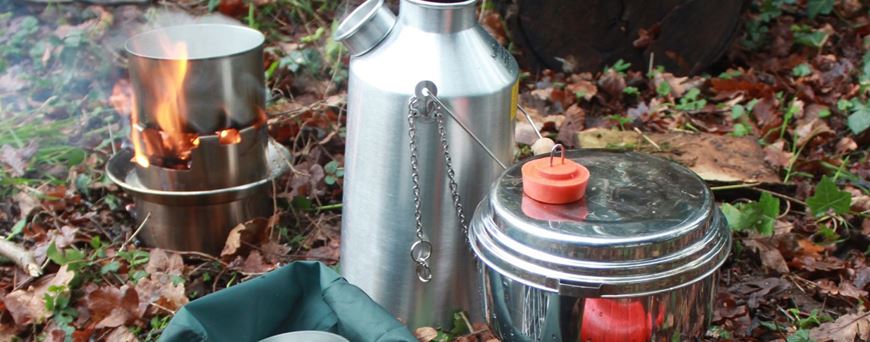The Kelly Kettle is an outdoor kettle that works by making a fire inside the chimney of the device and this rapidly heats up the water chamber.
Kelly Kettle has been making these all-in-one fire kettles since the 1890's, so they're a well-established company. The Kelly Kettle comes in three sizes, and I'm testing the largest option - the 'Base Camp' model. Surprisingly large actually.
All three models perform in the same way, with the only difference being the amount of water that can be boiled - ranging from 0.5 litres up to the 1.6 of the Base Camp.
As well as being sold separately, Kelly Kettle also packages up kits with a number of accessories. The Base Camp Ultimate Kit comes with a Cook Set, Pot Support, Hobo Stove, Cup Set and carry bag.
With this kit in different combinations, as well as heating up water you can also cook food using the Hobo Stove. It's quite adaptable in its design.
I'm testing the aluminium version, but there is a stainless steel option too. It's lightweight and fairly compact but, given its size, Kelly Kettle acknowledge that it isn't the best option for backpacking. Instead, it's primarily billed as suitable for car camping, fishing, picnics, scouts and the like. The stainless steel option is a bit heavier, but tougher and less likely to dent.
To give it a good test, a friend and I popped out to some local woods and set up the Kelly Kettle. I also took along my MSR Whisperlite, which can be seen for size comparison in the photo.
I have been looking at Kelly Kettles for years and always thought they looked cool. I can just imagine myself and friends sat around one of these camped out enjoying the summer. Sadly it's a wet January day today, but I can dream.
It's easy to get the fire going quickly with small sticks, though you do need to keep an eye on the fire as if you don't constantly feed it through the top it can die out fairly quickly. I was surprised how quickly it boiled the 1.6 litres of water - around five minutes. With a bit of practice, I reckon you could reduce this time a little.
Next it was time to try out some of the toys that we have.
We decided to use the Hobo Stove with the cooking pot to cook some soup up. It's a little tricky constantly feeding small sticks through the gap to fuel the fire, but you can't fault the results. The stove was very effective in heating up the soup quickly.
The Pot Support gives you the option of heating up some water at the same time as cooking. It's a nice idea, but not entirely practical as you need to keep lifting off the pot to fuel the fire with more sticks. The kettle's chimney design also limits heat to the middle of the pot, which isn't completely ideal for cooking.
The other issue here is the pot doesn't sit very well on top of the support. There's some potential for a slight redesign of this to ensure that it sits securely above the kettle. As it stands, having a flat and level section of ground for the kettle is vital - otherwise the whole stove can become unstable.
Not something you want with fire, boiling water and the risk of your lunch hitting the deck.
The performance of the accessories is a bit of a shame, because little things knock down the Kelly Kettle. The finish on some of the parts (such as the pot gripper handle) could be better as the machined edges feel a little rough.
Even for an extra £10, I can't help but feel that some of these little bits could have been finished to the same standard as the rest of the product. The kettle itself is very nicely made.
So what alternatives are there to this setup?
There are obviously lots of gas and fuel burners on the market, but two obvious wood-burning alternatives are the Storm Kettle (almost identical and without as many accessories, but with a similar price) and the BioLite stove.
The BioLite will cook your food and keep your gadgets charged. It's the expensive option, and probably targeted at a younger and more gadget-hungry audience, but at least you can listen to your favourite tunes while cooking.
As for the Kelly Kettle, would I take this up to the top of Tryfan? Not really - mainly because of the bulk and lack of wood at the top of the climb. In that scenario you're much better off taking a small gas stove.
However, that isn't neccesarily what the Kelly Kettle is designed for and I'd definitely take it on a canoe trip down the Wye.
What a cool talking point to have for the centre of your camp.
Pros
Lot of options with the accessories. Quick to boil water once the fire is established. Clever packaging.
Cons
Needs dry fuel, so not ideal for mountain survival. Large in comparison to gas stoves.
Recommended Use
Great when carrying the kettle isn't an issue and you're certain there will be a good supply of dry fuel. Perfect for fishing, picnics and car camping.












